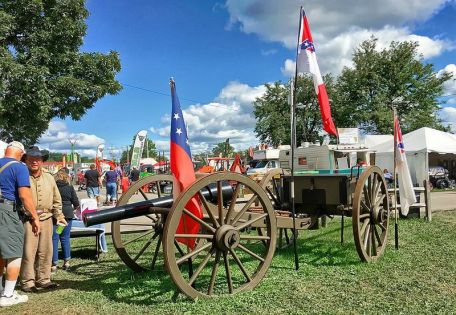History of the 10lb Parrott Model 1861 Rifle
Before the American Civil War (1861-1865), Robert Parker Parrott served as a captain in the United States Army. Based on this experience, Parrott accepted the position of Director of the West Point Foundry and began to design and develop several artillery pieces centered on cast iron structures. The switch from bronze to iron cannons is interesting - the cannon can now be towed internally, which improves range accuracy. In addition, they proved to be lighter than comparable battlefield debris at the time, and iron proved to be more abundant in the industrialized North.
Parrott's experiments soon led to the U.S. Army adopting a line of field guns of 10 lb, 20 lb, 32 lb, 100 lb, 150 lb, 200 lb, 250 lb and 300 lb.
The "10lb Parrott Rifle" has a 2.9" caliber and fires a slender 10lb projectile made specifically for the gun, and the suspension is fitted with a two-wheel slide system with a single tow arm. There was no recoil system, so the gun was free to move back with each shot, forcing the crew to reposition and re-target their cannon before firing.
The first model was called the "Model 1861 10 Pound Rifle". Loading is done by inserting a powder charge, followed by a projectile, both of which are rammed into the barrel by a push rod.
However, any apparent benefits of tuning iron-tube guns were quickly called into question. Iron proved too brittle for the inherently violent forces involved in firing a cannon, causing the breech to crack or shatter, which could (and often) prove fatal to the riflemen themselves (due to their size and weight at most 8 weapons). as well as the weight and general motion of each projectile required for effective fire). To solve this problem, a thick wrought iron band was designed, which, while still hot and malleable, wrapped around the outer surface of the breech section of each gun.
Once cooled, these straps provide tight, reinforced structural support in the most lethal parts of the weapon.
With this, the Model 1861 Parrott rifles entered a period of intensive use, and their numbers meant they would be used by both sides of the conflict. The 10-pound form was comparable to Napoleon's in 1857 on the battlefield, which proved to be excellent field guns throughout the conflict, although the Parrott rifle's longer rifle range and overall lighter weight made them more tactically useful. Value, and is relatively easier to handle under fire.
Accuracy is up to about 2,000 yards, though still somewhat effective below 3,000 yards, giving the rifle set a great range against the enemy. The barrel alone weighs 1,750 pounds, and the 10-pound projectile relies on a 2-pound charge. Combine these stats with the base weight of the car and you start to get an idea of ??the total weight required to maneuver the artillery of the period (even those of similar designs appearing in Europe at the time).
A full battery of these guns might consist of several Parrott rifles with appropriate benders and caissons, and a total of nearly 100 or more cavalry troops in support heavily deployed with guns, men, beasts, and supplies.
However, the problem of brittle iron remains. The weapon still ruptures under pressure, although the rupture now occurs before the breech band in the middle of the barrel length. Parrott rifles, while not entirely reliable in use, are still available in requested quantities and their use continues. Riflemen simply dealt with the possibility that the barrel would explode with every shot, keeping their spirited guns alive and dead. Parrott rifles have proven to be versatile as they can be deployed on mobile battlefields or as static units to protect critical installations.
Parrott rifles are manufactured at West Point Armory in Cold Spring, New York. The Confederate factory managed to replicate the type with its Georgia-based factory, appearing under the Noble Brothers Foundry and Macon Arsenal brand labels.
The Confederate version differs in the use of the "Brook" style rifle (developed by John Mercerbrook).
The 10-pound Parrott rifle appeared at the famous Battle of Gettysburg on behalf of New York's Fifth Battery. The guns can reportedly hit targets up to 2,100 yards away with generally high accuracy. In 1863, the Union Army adopted the 10-pound Parrott rifle in the 3-inch caliber, and these versions soon replaced the 2.9-inch form.
These also lose the recognizable nose shape.
Model 1861 10lb Parrott Rifle Specification
Basic
Roles
- fire support/attack/damage
Dimensions
1 ton (900 kg; 1,984 lb)
Performance
Performance
1 mile (2 km)
Armor
1 x 2.9" Rifled Iron Barrel.
Depends on ammo carrier/available supply.
Changes
Model 1861 - Original production model with 2.9" hole.
Model 1863 - Update and follow-up model in 3.0" caliber; lacks muzzle bulge.
Brooke Rifle - CSA production copy based on the Model 1861 series.





